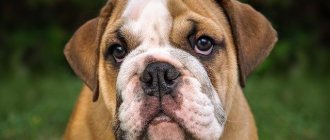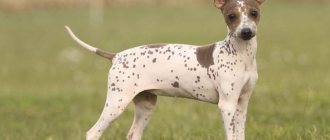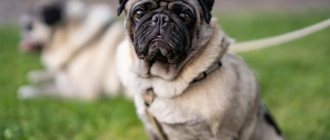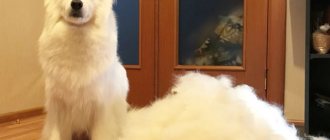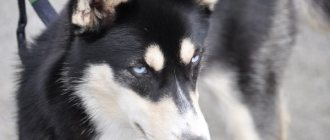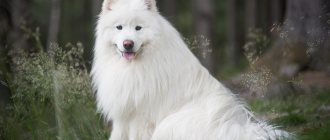Dogs are the best pets. They are devoted and faithful, always ready to rush to the aid of their owner, giving all their love unconditionally. But not all dogs are the same - some are excellent sitters and climbers, while others are divers and rescuers. In this article you will find a list of four-legged friends for which water is their natural habitat. Watch the video to get to know them better!
Newfoundland
This gentle giant was born to swim. It is given webbed toes and thick fur designed to keep it warm from cold water. Originally bred to help fishermen pull in nets, this breed, worth up to RUB 150,000, is now used primarily for water rescue. Despite its large size, the dog is known for its sweet disposition and makes a great family dog for those who can provide it with the amount of exercise needed to keep the dog happy.
More about the Newfoundland breed
Poodle
Despite its striking appearance, this dog was originally a hunting retriever. The fact is that the breed was bred as a water game hunter. Between the 16th and 18th centuries, poodles were used for water hunting throughout Europe and Russia. It was the poodle’s love of water that gave it its name: the German “Pudel” and the English “poodle” come from puddle (Pfuhl, Pfuetze), paddeln (to row with an oar).
This is a very intelligent breed that is easy to train, affectionate, and has a thick coat that is considered hypoallergenic.
Saint Bernard
Perhaps even people who are far from dog breeding in general know about this breed. The thing is that a dog of this particular breed starred in the well-known film “Beethoven”. Unlike divers, St. Bernards do not like “water procedures” too much. But they are great for working in high altitude conditions. They are able to find people caught in an avalanche in any weather and at any time of the day.
Due to their large size and incredibly developed undercoat, St. Bernards are able to withstand extremely low temperatures for a long time, while maintaining efficiency and a cheerful mood. Often, dogs rescuing people in the mountains have containers of water or alcohol attached to their collars, and backpacks with insulating blankets and dry rations are hung on their backs. Due to their size, St. Bernards can easily carry a few extra pounds, and rescued people can immediately quench their thirst, eat and warm up.
stuffed dog Barry
Interesting!
The most famous St. Bernard in history is considered to be a dog named Barry. According to official statistics alone, he saved about 50 people caught in an avalanche or lost in the mountains.
Portuguese water dog
Originating from the Algarve region of Portugal, references to this breed date back to 600 BC. e. They were originally bred to catch fish and work as couriers between ships and shores. This dog's webbed feet make him a stellar swimmer who still loves the water, even if it's just for recreation these days. The Portuguese dog is known as an intelligent, easy to train, but fun-loving family companion.
Irish Water Spaniel
Originally bred in the Emerald Isles, it is one of the most intelligent breeds in the world. The dog's characteristic thick, curly coat is water-repellent, making it an ideal dog for catching waterfowl. This playful, lively, high-energy breed is quite rare, but makes a great pet for the experienced dog owner who stays active...and can have access to a lake. The ideal entertainment for this dog is to catch a stick or toy thrown into a pond.
Labrador Retriever
This well-known water-loving breed is actually a mixture of English, Irish and Portuguese working breeds. Although its ancestors stretched ropes across the water, towed boats, and hauled fish and nets from the cold waters of the North Atlantic, much of the work Labradors do on the water today is more geared toward harvesting waterfowl for hunters. Their gentle, loyal and highly trainable nature makes them ideal for disabled guide dogs and wonderful family pets.
More about the Labrador Retriever breed
Spanish water dog
This hard-working breed originally accompanied fishermen on their boats and also stood guard on the shore, guarding the day's catch. As a strong swimmer, this dog can dive up to six meters underwater and stay underwater for a long time! She is intelligent and loves to learn new tasks and work, but her strong will and headstrong nature mean she needs an experienced owner.
German Shepherds
It is not for nothing that “Germans” are considered one of the most unique and useful breeds. But, contrary to popular belief, they are actively used not only for the needs of the army and police, but also as members of rescue teams. Yes, German shepherds cannot dive tens of meters, and they can withstand the brutal conditions of the highlands much worse than St. Bernards. But this breed is more versatile and flexible.
For example, in the highlands of the Austrian Alps, German shepherds are used in police stations with equal success both to search for crooks and to rescue people lost in the mountains. These dogs have an excellent sense of smell, so they can find a person within a couple of hours.
Nova Scotia Retriever
The double water-repellent coat of this breed makes it suitable for swimming in cold water. The dog is known for its ability to "knock down" or catch waterfowl and return them to its owner. Its intelligence, affection and patience with children make it a wonderful family dog, while its high energy level and sociable nature require a high level of exercise, including swimming.
Breed traits
Breed traits (on a 5-point scale)
| Newfoundland | |||
| Activity | in the house | 1.5 | |
| on the street | 2.3 | ||
| Obedience | training | 3.6 | |
| strangers | 3.8 | ||
| Domination | in family | 1.5 | |
| over dogs | 1.8 | ||
| Defending your territory | from people | 1.1 | |
| from dogs | 1.4 | ||
| Sociability | in family | 4.2 | |
| with strangers | 3.8 | ||
| with dogs | 3.3 | ||
| Concentration | in family | 2.2 | |
| in front of strangers | 2.3 | ||
| with dogs | 2.5 | ||
| Aggressiveness | in family | 1.2 | |
| to strangers | 1.4 | ||
| to the dogs | 1.5 | ||
| to cats | 1.8 | ||
| Family behavior | calmness | 3.9 | |
| demand for affection | 3.5 | ||
| excitability | 2.2 | ||
| playfulness | 3.1 | ||
| excessive barking | 1.5 | ||
| behavioral breakdowns | 1.8 | ||
| Tolerance for children | up to 4 years | 4.5 | |
| over 4 years old | 4.6 | ||
| Institutional use | watchman | 2.2 | |
| bodyguard | 1.5 | ||
This breed is often compared to the following dog breeds: St. Bernard, Labrador Retriever, Caucasian Shepherd, Leonberger, Golden Retriever.
The photographs show what Newfoundlands look like:
Newfoundland dog
Newfoundland breed
Newfoundland dog face
Dog diver
Diver
Chesapeake Bay Retriever
As the name suggests, these hardy water dogs are native to the Chesapeake Bay in Maryland. They were once used to catch ducks in cold, icy water. Their dense and waterproof coat allows them to withstand adverse weather conditions and cold water. Like Labradors, they are tireless workers, but unlike Labradors they are quite stubborn and require training from experienced dog trainers who can offer the appropriate exercise (ideally in the water) that this determined guy needs.
Care and maintenance
The best place to keep a Portuguese Water Dog is a private house with a spacious, securely fenced area. But with daily walking, the Wasserhund adapts well to apartment life.
Important! The Portuguese Water Dog has no undercoat at all. Therefore, she does not tolerate frost well and cannot live outside all year round.
Hygiene procedures
In order for the Portuguese Water Dog to have a well-groomed appearance, it is combed every 2-3 days with special combs and brushes for curly, long-haired breeds. Several times a year, the Wasserhund is taken to the groomer and cut in accordance with the requirements of the standard.
The working dog's coat is uniformly shortened to 25 mm, leaving the tip of the tail intact. An exhibition Wasserhund is cut like a lion, removing as much hair as possible from the waist, hind legs and back of the body. A long pompom is left on the animal's tail.
The Portuguese Water Dog's water-repellent coat does not require frequent washing. They bathe the Wasserhund 2-3 times a year using pet shampoos for curly breeds.
The Portuguese Water Dog's ears are cleaned weekly with cotton swabs soaked in hydrogen peroxide or chlorhexidine.
The Wasserhund's eyes are wiped every morning with napkins moistened with chamomile infusion or settled boiled water.
The Portuguese Water Dog's teeth are brushed 2-3 times a week with a special brush and veterinary paste. To prevent the formation of stones, the Wasserhund is regularly given various chews, such as raw hard vegetables or beef bones.
On a note. If, during an examination of the eyes and ears of your Portuguese Water Dog, redness, purulent or foul-smelling discharge is discovered, it is better to take the animal to the veterinarian.
Feeding
Portuguese Water Dogs are active animals that require a high-quality, high-protein diet to replenish their energy. The easiest way to provide your Wasserhund with all the required nutrients is using ready-made industrial food.
When choosing a dry diet for your Portuguese Water Dog, it is recommended to give preference to imported premium or super premium products, such as Acana, Orijen, Belcando or Hills.
Saving on wasserhund food will sooner or later result in expenses for the veterinarian. Therefore, if it is not possible to regularly buy high-quality dry food for your Portuguese Water Dog, it is better to switch it to natural food. In this case, the basis of the Wasserhund's diet should be fresh meat, such as lean lamb, horse meat or beef. It is better if it has veins and cartilage.
Twice a week, instead of meat, it is recommended to feed the Portuguese water dog giblets and fillets of sea fish. You can also give your Wasserhund:
- porridge;
- eggs;
- vegetables;
- sour milk.
During the period of active growth and change of teeth, it is advisable to introduce calcium-containing supplements into the diet of the Portuguese Wasserhund.
On a note. To maintain the health of the Portuguese Water Dog, fatty meat, sweets, smoked meats, pickles, sausages and any leftovers from the master's table are completely excluded from its diet.
Walking and exercise
The Portuguese Water Dog is an active dog that suffers from lack of exercise. To maintain her muscle corset, she needs two daily walks with a total duration of about 3 hours a day.
It is important that while outdoors the Wasserhund receives not only physical, but also mental exercise. To do this, during walks, the Portuguese Water Dog is introduced not only to swimming or running, but is also forced to perform intellectual tasks of searching for objects.
Training and education
The Portuguese Water Dog is a smart and intellectually developed dog that can be trained well. Its training can be easily handled by a novice dog breeder who has no experience in training. But if the owner is not confident in his abilities, it is better to turn to a professional.
The Portuguese Water Dog quickly gets tired of monotonous tasks. Therefore, the process of raising her requires a creative approach. The key to successful training of a Portuguese Wasserhund is intensive, systematic training and interesting, varied tasks.
Puberty and mating
Portuguese merman reach sexual maturity at 6-10 months. But early pregnancy has a bad effect on the health of animals and often ends in the birth of non-viable or sick puppies. Therefore, it is recommended to untie the Portuguese no earlier than two years.
For mating, completely healthy, purebred dogs with good genetics and standard conformation are selected. Mating is carried out on days 11-14 from the start of estrus and repeated 1-2 days later. Mating takes place in the morning and preferably in the territory of the male.
Pregnancy in Portuguese merman lasts on average 60-64 days, and there are 4-8 puppies in a litter.
Caring for puppies
A Wasserhund puppy from a good nursery falls into the hands of new owners no earlier than 8-9 weeks. Therefore, future owners can calmly prepare for the arrival of their pet and buy everything they need to care for it.
The list of “puppy dowry” includes:
- bowls for water and food;
- various toys;
- bed with removable covers;
- equipment for walking;
- hygienic cosmetics;
- disposable diapers;
- grooming tools.
On a note. For a rapidly growing Portuguese Water Dog puppy, it is recommended that you buy a budget collar as he will soon become small. When the Wasserhund grows up, he will be able to choose expensive and high-quality ammunition.
To prevent the agile and inquisitive Portuguese merman puppy from getting into trouble, household chemicals, medicines, wires and fragile objects are prudently hidden in the house. Also, for hygiene reasons, all carpeting is removed from the floor.
To protect the Wasserhund puppy from viruses and infections, until it receives all preventive vaccinations and completes quarantine, it is not allowed to walk and is limited in communication with other people’s animals.
English Setter
Swimming is this hunting breed's favorite pastime, and once on a river, it can be difficult for them to get out of the water. These dogs are very smart and are actually known for their memory, so they don't forget anything! While they need intense exercise outdoors, indoors they need nothing more than to cuddle with children. Its sociable nature makes the dog an excellent pet.
More information about the English Setter breed
Character
The dog is considered a great companion. Her whole life was focused on the unconditional fulfillment of human orders. A stable mental state prevents the dog from showing excessive emotions.
Exceptional devotion to its owner and the ability to quickly adapt to changing living conditions, a calm, calm disposition and hard work become additional advantages of the pet.
She treats all family members quite normally, but prefers to obey only the owner. For him alone, devotion and desire to please are prepared.
At the same time, the pet requires a respectful attitude; lisping and excessive enthusiasm are not suitable for its serious character.
Note!
Nicknames for dogs for boys - easy, rare and most beautiful names for dogs in alphabetical order
Nicknames for girls' dogs - a list of beautiful, funny, unusual nicknames for large and small dog breeds
Maltipoo dog - everything about the dog from A to Z. Photos, description of the breed, character, maintenance features, prices, reviews
He behaves very carefully and carefully with children, gets along well with older people. In European clinics and nursing homes, dogs of this breed are specially kept to relieve depression in residents.
The dog is quite sociable, so all other pets can become good friends and playmates for him.
The dog will be friendly with visiting guests and unfamiliar people. The dog may show independence and excessive childishness, which can be corrected with early training.
Attention to detail, keen sense of smell, equanimity and willingness to help complete the portrait of the Portuguese Water Dog.
Flat-Coated Retriever
An English hunting dog breed derived from the Labrador Retriever, Setter and Pointer, it was originally bred in Great Britain. These dogs feel great on the water, in forests, and steppes. This is a serious working breed that without proper training can become pampered and lazy.
The dog is very intelligent and easy to train, but he is also full of energy and enthusiasm and can therefore be a bit noisy.
Add a comment

